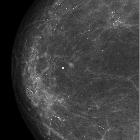parenchymal patterns in breast imaging
Parenchymal patterns in breast imaging influence mammographic screening sensitivity and is related to the risk of breast cancer. This article describes the historical classifications of breast density. See the main article on breast density for the currently accepted BI-RADS descriptors.
Classification
Pioneers in classification of density include Leborgne in 1953 and Wolfe in 1967, who described an increased risk of breast cancer in radiographically dense breast.
Wolfe classification
The first qualitative classification of mammographic density patterns was described by Wolfe in 1976. Wolfe assigned the mammograms to four parenchymal patterns (N1, P1, P2 and Dy) according to the distribution of fat and the prominence of the ducts:
- N1: the breast consists mainly of fat (N = normal)
- P1: this pattern includes fat as well as linear densities (enlarged ducts) occupying no more than 25% of the breast
- P2: linear densities (from enlarged ducts) occupying more than 25% of the breast. They are prominently in the upper outer quadrant but may be distributed throughout the breast (P=prominent ducts)
- Dy: dense, radiopaque breast (Dy=dysplasia); these patterns are again subdivided into low-risk (N1 and P1) and high-risk (P2 and DY) patterns
A fifth category was later added by Wolfe:
- Qdy (quasi-dysplasia): this group consists of young women whose dense breast have a somewhat spongy texture due to fatty infiltration
Boyd classification
An alternative, quantitative method proposed by Boyd and colleagues (1980) was based on mammographic density percentage given by radiologists and divided into six categories of unequal intervals:
- A: 0%
- B: >0-10%
- C: >10-25%
- D: >25-50%
- E: >50-75%
- F: >75%
Tabar classification
Tabár (1997) classifies the mammograms in five patterns (I to V) based on an histologic-mammographic correlation with a three-dimensional, subgross (thick-slice) technique, and on the relative proportion of four “building blocks” (nodular densities, linear densities, homogeneous fibrous tissue, radiolucent fat tissue):
- I: balanced proportion of all components of breast tissue with a slight predominance of fibrous tissue
- II: predominance of fat tissue (fat breast)
- III: predominance of fat tissue with retroareolar residual fibrous tissue
- IV: predominantly nodular densities
- V: predominantly fibrous tissue (dense breast)
Patterns I, II and III are considered low-risk; patterns IV and V high-risk.
It is important to consider that some therapies may alter the pattern by increasing parenchymal density, as in hormone replacement therapy (HRT), or reducing it as in therapies with selective estrogen-receptor modulators (SERM).
Prior version of BI-RADS classification of density
The prior, 4th edition of BI-RADS used a semi-quantitative method proposed by the American College of Radiology (2003) . It was a modification of Wolfe’s classification, defined using percentages of density divided into quartiles:
Siehe auch:
- Mastitis
- Breast imaging-reporting and data system (BI-RADS)
- inflammatorisches Mammakarzinom
- altered breast density between two mammograms
- Boyd classification mammography
- Wolfe classification of breast density
- low weight effect on mammogram
- Neoplasien der Mamma
und weiter:
 Assoziationen und Differentialdiagnosen zu Brustdichte in der Mammographie:
Assoziationen und Differentialdiagnosen zu Brustdichte in der Mammographie:










